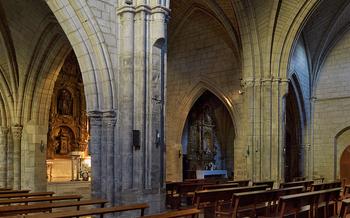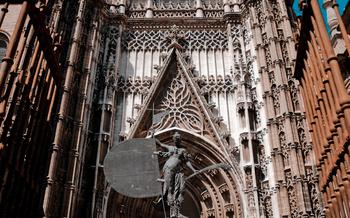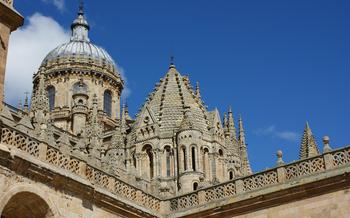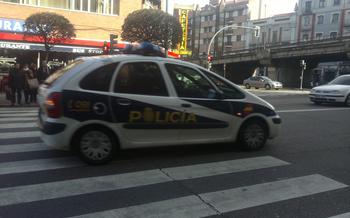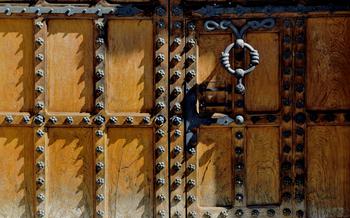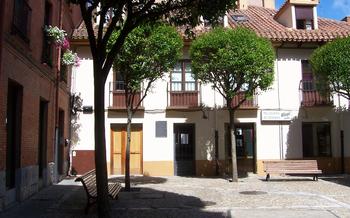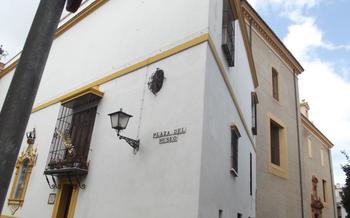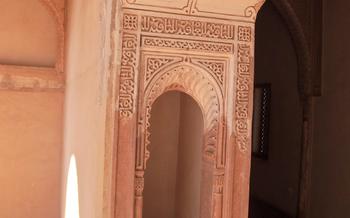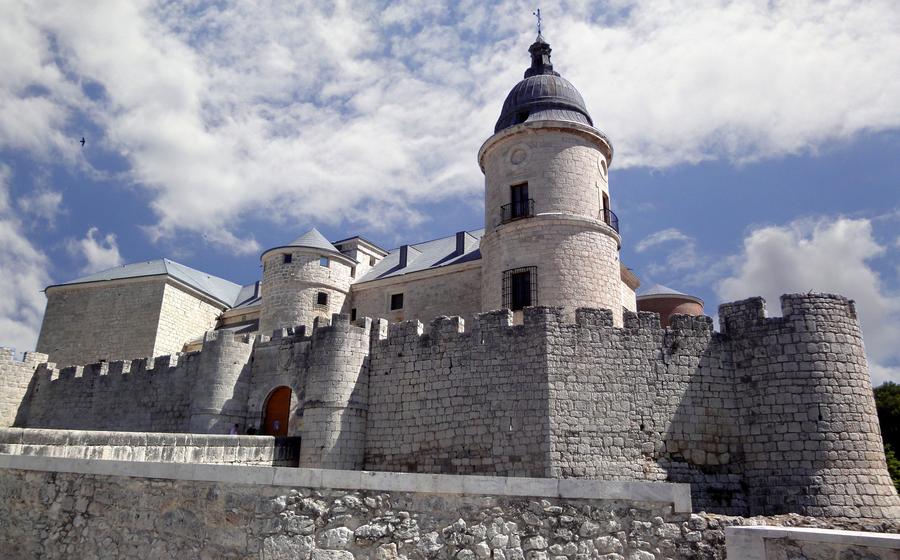
Archivo General de Simancas
- Unique Collections
- Research Opportunities
- Guided Tours
- Location and Accessibility
- Hours of Operation
- Admission Fees
- Facilities
- Nearby Attractions
- Photography and Videography
- Dress Code
- Language Services
- Souvenirs and Gifts
Unique Collections
The Archivo General de Simancas houses an extraordinary wealth of documents that offer invaluable insights into the history of Spain and its vast empire. These collections encompass a diverse range of materials, including royal decrees, treaties, financial records, maps, plans, and personal correspondence. Among the most notable highlights are the documents related to the discovery and colonization of the Americas, including the original will of Christopher Columbus and the reports of Hernán Cortés on the conquest of Mexico. The archive also holds a significant collection of medieval manuscripts, including the famous Codex Calixtinus, a richly illuminated manuscript from the 12th century that served as a guide for pilgrims traveling the Camino de Santiago. Furthermore, the archive possesses an impressive collection of documents relating to the Spanish Inquisition, shedding light on the inner workings of this powerful institution.
Research Opportunities
The Archivo General de Simancas is a treasure trove for researchers interested in Spanish history and culture. The archive's vast holdings offer a wealth of primary source material for scholars from various disciplines, including history, genealogy, law, and literature.
To access the archive's collections, researchers must obtain a reader's card. This can be done by submitting an application form to the archive's administration. Once approved, researchers will be granted access to the reading room, where they can view and study the documents.
The archive's staff is knowledgeable and helpful, and they can assist researchers in finding the materials they need. Researchers are also encouraged to take advantage of the archive's online catalog, which provides a detailed listing of the collections.
Planning a research trip to Simancas requires careful consideration. Researchers should plan their visit in advance, especially if they have specific documents they wish to consult. It is also important to consider the time of year, as the archive is closed on certain holidays and during the month of August.
For a successful research experience, researchers should come prepared with a list of the documents they wish to consult, as well as any necessary research tools. It is also advisable to bring a laptop or tablet for taking notes and storing digital copies of documents.
The Archivo General de Simancas is a world-renowned research institution that offers a wealth of opportunities for scholars. With its vast holdings and helpful staff, the archive is an essential resource for anyone interested in the history and culture of Spain.
Guided Tours
Guided tours of the Archivo General de Simancas are available in various languages, including English, Spanish, French, and German. Tours typically last for about an hour and provide visitors with an in-depth look at the archive's history, collections, and highlights.
During a guided tour, visitors will learn about the role that the archive has played in preserving Spanish history and heritage. They will also get to see some of the archive's most valuable and rare documents, such as the Treaty of Tordesillas, which divided the world between Spain and Portugal in 1494, and the will of Ferdinand and Isabella, which established the Spanish monarchy.
Guided tours are a great way to learn more about the Archivo General de Simancas and its collections. They are also a good option for visitors who are short on time or who want to make the most of their visit.
To book a guided tour, visitors can contact the archive in advance by phone or email. Tours are available on weekdays during the morning and afternoon.
Location and Accessibility
The Archivo General de Simancas is situated in the historic town of Simancas, just a short distance from the city of Valladolid in the Castile and León region of Spain. The exact address of the archive is Calle Real, 7, 47151 Simancas, Valladolid.
Getting to Simancas:
-
By car: Simancas is easily accessible by car from Valladolid and other major cities in the region. Take the A-62 motorway towards Simancas and follow the signs to the archive. There is ample parking available near the archive.
-
By bus: There are regular bus services from Valladolid to Simancas. The journey takes approximately 30 minutes.
-
By train: The nearest train station to Simancas is Valladolid-Campo Grande. From the train station, you can take a taxi or bus to Simancas. The journey takes approximately 20 minutes.
Hours of Operation
The Archivo General de Simancas is open to the public from Monday to Friday, except on public holidays. The archive's hours of operation are:
- Monday to Friday: 9:00 AM to 2:00 PM and 4:00 PM to 7:00 PM
It's important to note that the archive may have reduced hours during certain times of the year, such as during the summer months. It's always advisable to check the archive's website or contact them directly before planning your visit to confirm their current hours of operation.
To make the most of your visit, it's recommended to plan your research in advance and arrive early in the morning to avoid crowds. The archive's staff is typically less busy during the morning hours, and you'll have more time to explore the collections and ask questions. If you're visiting during the summer months, it's advisable to come early in the morning or late in the afternoon to avoid the heat.
Admission Fees
Admission to the Archivo General de Simancas is free of charge for all visitors. This includes access to the reading room, where researchers can consult the archive's collections. However, there may be a small fee for photocopying or scanning documents.
For guided tours, there is a standard fee of €5 per person. This fee includes a guided tour of the archive's most important areas, as well as access to the reading room. Guided tours are available in Spanish, English, French, and German.
Groups of 10 or more people can receive a discounted rate of €4 per person. To arrange a group tour, please contact the archive in advance.
The best time to visit the Archivo General de Simancas is during the week, when there are fewer visitors. The archive is closed on Mondays and public holidays.
Facilities
The Archivo General de Simancas provides a range of facilities to enhance the research experience and cater to the needs of visitors. Within the archive's premises, researchers have access to a well-equipped research library, which houses a comprehensive collection of books, journals, and reference materials related to Spanish history and archival studies. The library offers a quiet and conducive environment for researchers to delve deeper into their chosen topics.
For those seeking refreshments or a quick bite, the archive features a cafeteria that serves a variety of snacks, beverages, and light meals. Visitors can take a break from their research and socialize with fellow scholars or simply relax and recharge before continuing their exploration of the archive's treasures.
Additionally, the Archivo General de Simancas has a gift shop that offers a selection of unique souvenirs and mementos for visitors to take home. These items range from books and postcards to replicas of historical documents and other commemorative items, providing a tangible reminder of the archive's rich history and collections.
To ensure accessibility for all visitors, the archive is equipped with accessibility features such as ramps, elevators, and adapted restrooms, making it easy for individuals with disabilities to navigate the premises and access the collections. The staff at the archive is also committed to providing assistance and support to visitors with disabilities, ensuring an inclusive and welcoming environment.
Nearby Attractions
In addition to the Archivo General de Simancas, the town of Simancas offers several other historic sites and attractions that are worth exploring. One of the most notable is the Castle of Simancas, a medieval fortress that dates back to the 15th century. The castle served as a prison during the Spanish Inquisition and today houses a museum that tells the story of its history.
Another must-see attraction in Simancas is the Church of Santa María la Mayor, a 16th-century Gothic church that contains a stunning altarpiece by the Spanish artist Alonso Berruguete. The church is also home to the Museo Parroquial de Santa María la Mayor, which houses a collection of religious art and artifacts.
For those who want to learn more about the history of the region, the Museo de los Comuneros is a good place to start. The museum tells the story of the Comuneros Revolt, a 16th-century uprising against the rule of the Holy Roman Emperor Charles V.
For those looking for a day trip from Simancas, there are several nearby destinations that are worth considering. The city of Valladolid, the capital of the province of Castile and León, is just a short drive away and offers a wealth of historic and cultural attractions, including the Cathedral of Valladolid, the Plaza Mayor, and the Museo Nacional de Escultura.
Another popular day trip destination is the town of Medina del Campo, which is home to the Castle of la Mota, a 15th-century fortress that once served as a prison for King Ferdinand II of Aragon. Medina del Campo is also known for its Plaza Mayor, one of the largest and most beautiful squares in Spain.
Photography and Videography
The Archivo General de Simancas has a strict policy regarding photography and videography within its premises. Taking pictures or recording videos is strictly prohibited in the reading rooms and storage areas where the documents are kept. This is to ensure the preservation of the delicate historical materials and to maintain the privacy of researchers working in the archive.
However, visitors are allowed to take photographs of the exterior of the building, the courtyards, and the public spaces of the archive. Please be respectful of other visitors and staff when taking photos, and avoid using flash or tripods that may disturb others.
If you are a researcher or journalist interested in using images or footage from the archive's collections for publication or broadcast, you must obtain prior permission from the archive's administration. Please contact the archive directly to inquire about the specific requirements and fees associated with using their materials.
By following these guidelines, you can help preserve the integrity of the Archivo General de Simancas and its priceless collections for future generations.
Dress Code
When visiting the Archivo General de Simancas, appropriate attire is expected to maintain the decorum and respect for the historical significance of the institution. Visitors should dress in a manner that is both respectful and comfortable, allowing for ease of movement while exploring the archive's collections.
For researchers using the reading room, a more formal dress code is required. This includes business casual attire, such as dress pants or skirts, blouses or shirts with collars, and closed-toe shoes. The reading room environment demands a quiet and professional atmosphere, and appropriate attire contributes to this ambiance.
It is important to note that the archive's dress code policy is in place to ensure a respectful and conducive environment for all visitors. By adhering to these guidelines, visitors can contribute to the preservation and appreciation of the invaluable historical documents housed within the Archivo General de Simancas.
Language Services
The Archivo General de Simancas recognizes that researchers and visitors from around the world may not be fluent in Spanish. To ensure that these individuals can still access and appreciate the archive's treasures, several language services are available.
For researchers who require assistance with reading and understanding Spanish documents, the archive offers translation services. A team of experienced translators can help researchers translate specific documents or provide general guidance on deciphering the often-complex language of historical texts.
For visitors who prefer to experience the archive through guided tours, there are options available in several languages. English-speaking tours are offered regularly, and other languages, such as French, German, and Italian, may be available upon request. These tours provide a comprehensive overview of the archive's history, collections, and significance, allowing visitors to gain insights into Spanish history and culture in their own language.
Souvenirs and Gifts
The Archivo General de Simancas gift shop is a treasure trove of unique souvenirs and gifts that will remind you of your visit to this historic institution. From replicas of ancient manuscripts and maps to books on Spanish history and culture, there's something for everyone. You can also find a selection of local crafts and products, such as ceramics, leather goods, and wines, that make great souvenirs for friends and family back home.
If you're looking for something truly special, be sure to ask about the limited-edition prints of historic documents that are available for purchase. These prints are made from high-quality scans of the original documents and are a great way to own a piece of Spanish history.
Whether you're a history buff, a genealogist, or simply someone who appreciates beautiful things, you're sure to find something to your liking at the Archivo General de Simancas gift shop.

